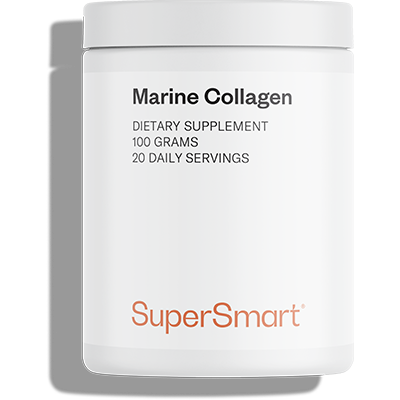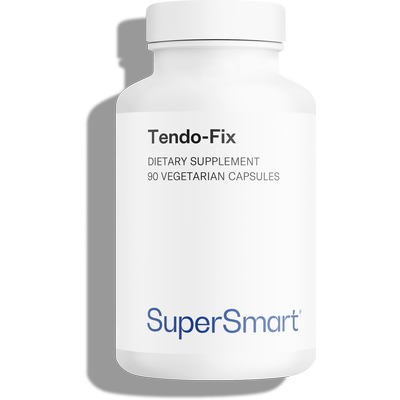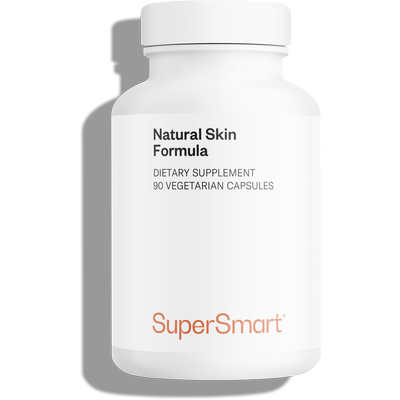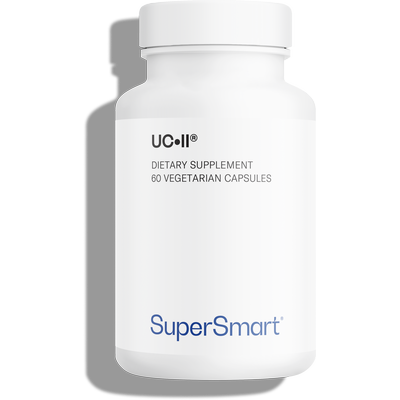Which collagen to choose?
Native, hydrolysed, marine, plant-based... With so many forms and so many promises, choosing your collagen can become a headache. Which collagen for the skin? For the joints? Discover all the secrets to making the right choice.

What is collagen and what is it used for?
Collagen is the most abundant structural protein in human beings: it represents a third of our total proteins and around 75% of the dry weight of the skin.
It is a fundamental protein in the tissue framework known as the extracellular matrix.
Here are some of its other functions:
- It is essential for healing.
- It is responsible for the firmness and plumpness of the skin.
- It ensures the strength and elasticity of our tissues (bones, tendons, muscles, etc.).
- It contributes to the normal function of cartilage and joints (1-2).
The body is capable of producing it from amino acids derived from the digestion of proteins in food.
Collagen synthesis involves 19 different amino acids, but 3 of them (glycine, proline and hydroxyproline) account for 57% of its composition. A dietary imbalance in these amino acids can therefore disrupt collagen production, which naturally declines from around the age of 25.
What are the dietary sources of collagen?
There are dietary sources of collagen, but they are consumed less and less by Western populations.
Here is a non-exhaustive list:
- bone broth (very rich in type I and II collagen).
- chicken skin.
- pork skin.
- chicken shanks and feet.
- fish skin.
- edible gelatine (rich in partially hydrolysed collagen).
- pigs' feet.
- calf's head.
- beef tongue.
- brawn.
- beef cheek and oxtail.
- offal, such as liver or kidneys.
Bear in mind that while these foods contain collagen, the collagen molecule will not be absorbed intact by the body. Instead, it is broken down during digestion into amino acids.
The body can reconstruct collagen from these basic building blocks that cross the intestinal barrier. It can also use them to make other proteins as needed.
It is important to remember that these natural sources of collagen should be consumed, as they provide the body with the right amino acids in the right proportions to 'follow the recipe'. Many people are turning to collagen supplements for good reason.
Note that seafood, eggs, nuts and seeds contain only collagen precursors and that all sources of vitamin C contribute to endogenous collagen synthesis.
What are the different types of collagen?
Contrary to what we sometimes read, there are not 4 types of collagen, but more than 28 different types, divided into 5 families: fibrillar collagen, sheet collagen, FACIT collagen, MACIT collagen and MULTIPLEXIN collagen.
Each type of collagen has a specific organisation and role within the body. We often talk about types I, II, III and V because they are the most abundant. Here is a breakdown of each:
- type I collagen (the most abundant): found in the skin, tendons and bone tissue. It is essential for the structure and strength of connective tissue, as well as for wound healing;
- type II collagen: specific to cartilage tissue (the tissue covering the bony surfaces of joints). In particular, it contributes to the structure of articular cartilage, helping to absorb impacts;
- type III collagen: found in skeletal muscle and vessel walls. In particular, it contributes to the resistance and elasticity of extensible tissues;
- type V collagen: widespread in bone, skin, cornea, etc. It plays a role in tissue development, mechanical resistance and membrane health.
You can choose your supplement according to the type of collagen it contains, but this is not an absolute necessity, as the molecules are often broken down into individual amino acids in the intestine.
What are the sources of collagen supplements?
Collagen food supplements generally come from one of the 4 sources we are going to describe, along with a ‘false’ plant source:
Bovine collagen: the most accessible
Bovine collagen is extracted from the crushed carcasses of bovine animals and comes from the waste products of slaughterhouses and factory farming.
Advantage: it is often inexpensive.
Disadvantages: its environmental impact; ethical concerns; increased risk of contamination by pathogens (such as prions); greater risk of allergic reactions in consumers.
Marine collagen: the safest
Marine collagen is extracted from fish products, mainly from the skin and bones of fish (Marine Collagen and Premium Collagen Shots are the reference supplements).
Advantages: fewer health risks; hypoallergenic (excluding fish allergies); potentially more responsible (some supplements contain collagen from sustainable fishing).
Disadvantage: generally more expensive.
Chicken collagen: the most targeted
Chicken collagen is composed mainly of type II collagen, whereas bovine and marine collagens contain mainly type I and III collagens (for example, the excellent UC-II® or Tendo-Fix, which combines it with eggshell collagen).
Advantage: more specifically targets joint health needs.
Disadvantage: less commonly available.
Eggshell collagen, the most expensive
Eggshell collagen comes mainly from the inner membrane of the eggshell and contains mainly type I collagen, but also traces of type V and X collagen (we have already mentioned Tendo-Fix, which contains both chicken and eggshell membrane collagen).
Disadvantage: more expensive because of the extraction process and its limited availability.
Plant collagen: the misconception
Contrary to popular belief, there is no such thing as ‘plant collagen’.
Plant-based supplements may contain the plant-based nutrients needed to make collagen, such as zinc or vitamin C, but never contain collagen itself.
The different forms of collagen
Hydrolysed collagen: the best absorbed
In its hydrolysed form, the collagen molecule is broken down into small pieces (collagen peptides of up to 5,000 Daltons).
This improves digestibility and maximises the number of amino acids from collagen that can cross the intestinal barrier. This is also known as collagen hydrolysate.
Many supplements opt for this high-quality form (such as Marine Collagen, Premium Collagen Shots, Natural Skin Formula).
Advantages: excellent bioavailability; ease of use.
Disadvantage: variable quality between supplements on the market (make sure you know the source and size of the collagen peptides).
Native collagen: for specific uses
Native collagen is the natural, whole form of the collagen molecule as extracted from animal tissue.
As its structure is preserved in its entirety, it is much more difficult to digest and therefore less easily assimilated by the body. However, its purpose is quite different: once in the intestine, the intact collagen molecule may influence the immune system and help reduce joint inflammation (generally type II collagen, as found in the UC-II® supplement, dedicated to joints).
Advantage: the immunomodulating properties of collagen are preserved.
Disadvantages: lower absorption (digestion does not fully break it down into amino acids, preventing the larger fragments from passing through the intestinal barrier—though this is often not the aim of the product); limited use; higher cost (due to more complex processing).
Gelatine: the least suitable
Gelatine is a substance obtained by the partial hydrolysis of animal collagen (generally of bovine or porcine origin).
Unlike fully hydrolysed collagen, it contains longer and heavier collagen peptides, which are less bioavailable to the body.
Advantages: less expensive than hydrolysed collagen; good source of glycine and proline; has gelling properties useful in cooking.
Disadvantages: lower bioavailability; possible allergens; potentially strong taste.
So what is the best form of collagen?
To sum up, hydrolysed collagen supplements are undoubtedly the best option for most collagen applications, as they are more easily absorbed by the body.
Native collagen, on the other hand, is reserved for more targeted needs.
Note that collagen supplements are often combined with other active ingredients, including:
- vitamin C, which contributes to the normal formation of collagen to ensure the normal function of the skin, bones, cartilage and blood vessels;
- hyaluronic acid, a molecule naturally present in the joints;
- zinc, which contributes to normal protein synthesis (including collagen synthesis) and helps maintain healthy skin.
This is the case with certain high-quality synergistic formulas (such as Premium Collagen Shots, presented in the form of drinkable sachets rich in purified and hydrolysed type I and III marine collagen, supplemented with Colartix® hydrolysed cartilage, hyaluronic acid, vitamin C, vitamin E and biotin).
The different forms of collagen
The form collagen comes in (powder, capsule, liquid) affects ease of use more than assimilation.
The most important thing is to choose collagen from a reliable source, adapted to your specific needs, whether for skin, joint or bone health.
Powdered collagen: the most flexible
This is generally hydrolysed collagen in the form of a fine powder, which is particularly popular because of its flexibility of use (this is the case with Marine Collagen, a type 1 powdered marine collagen supplement in the form of hydrolysed peptides).
Advantages: longer shelf life (less susceptible to degradation than liquid collagen); adjustable doses (which can be an advantage for those with increased needs, such as sportspeople); less bulky; easy to use (can be mixed into drinks, soups, salads, etc.); more affordable.
Disadvantages: preparation time; variable quality (beware of additives and excipients).
Collagen capsules: relatively practical
The capsule format appears to be very practical for a collagen supplement, but it often requires you to take several capsules in succession to achieve a significant dose.
They are nonetheless practical for those who travel or want a quick, no-preparation solution.
Advantages: ease of use; controlled dosage; good shelf life; total absence of taste.
Disadvantages: requires taking multiple capsules (each contains a limited quantity of collagen); less economical format.
Liquid collagen: the easiest to take
Liquid supplements have been identified as the most easily assimilated, because the collagen peptides are already dissolved and combined with other ingredients of interest, such as vitamin C (this is the case with Premium Collagen Shots, already mentioned several times, a hydrolysed type I and III marine collagen supplement in the form of drinkable sachets).
Advantages: ready-to-use; fast absorption; easy to carry around; often more pleasant taste.
Disadvantages: shorter shelf life; potential need to take several doses in cases of significantly increased need.
Collagen cream: primarily a moisturiser
Unlike oral supplements, collagen cream is applied directly to the skin.
Unfortunately, collagen peptides are too large to penetrate the deeper layers of the skin, so they act primarily as a moisturiser and do not contribute to collagen production in the dermis.
Oral supplements dedicated to the skin remain more relevant, especially if they also contain other beneficial ingredients (this is the case, for example, with the specific Natural Skin Formula).
It's worth noting that collagen is being presented in more and more innovative forms, such as smoothies, sweets or marshmallows. Be careful about the credibility of the manufacturer and the quality of the collagen on offer.
SUPERSMART ADVICE
References
- Brinckmann J. Collagens at a glance. Top. Curr. Chem. 2005;247:1–-6.
- Shoulders MD, Raines RT. Collagen structure and stability. Annu Rev Biochem. 2009;78:929-58. doi: 10.1146/annurev.biochem.77.032207.120833. PMID: 19344236; PMCID: PMC2846778.
Keywords
1 Days
Excellent quality products with…
Excellent quality products with innovative formulas, as someone who has been suffering with acid reflux, these supplements have been lifesavers.
Oriana Moniz
1 Days
high quality supplement!
high quality supplement!
GALANT
1 Days
Good service prompt delivery
Good service prompt delivery
Mrs Marcella Reeves
6 Days
I like your clear explanation
I like your clear explanation. And how to make a choice of products for a specific health problem
Ingrid
13 Days
Great product and it arrives quickly.
Great product and it arrives quickly.
SOMMARIVA Gianni
14 Days
Excellent products and fast service.
Excellent products and fast service. What do we need more?
Margarida
18 Days
The variety of products is amazing
The variety of products is amazing, the offers are good and the sending is very fast. I just miss having a bit more of guidance about combinations, possible interactions, etc.
Maria Angeles Verdu
19 Days
It was quick
It was quick.
Timo Antero
22 Days
Who is a good boy? You, you are! Yes, yes
:) :(:) :(:) :(:) :(
JORGE Catalan Gasco
24 Days
Excellent online site
Excellent online site, efficient and quick delivery. A great experience.
Chris
27 Days
I’m really happy with your products, but…
I’m really happy with your products. Indeed, I’ve been a customer of SuperSmart for a long time. However, I believe that lately you’ve made a significant mistake in choosing Poste Italiane for your deliveries. Poste Italiane is now over loaded and assigns the deliveries to small local companies that have grown like mushrooms because of this business. However, the service they provide is very poor. They let you know about the delivery date just the evening before, with no time to organize yourself, many times you receive a message saying that they tried to deliver but you were not home and in reality they haven’t come at all and, when they do come, you open the door of the building ( I live on the 3rd floor) and when you get downstairs they have already left, leaving the pack inside but right behind the glass door instead of at least putting it on top or under the letterbox. This is not just a one time event but it’s their way of proceeding. It would be worth hiring a professional currier. Thanks
Olga Gladys Del Signore
28 Days
Good products
Good products, fast service
Mrs I Heinrich
34 Days
Quality products and fast shipping.
Quality products and fast shipping.
JF
35 Days
Everything is great. Keep up
Your product and service is great that's why i ordered again.
KOSMATOS Stamatios
39 Days
everything as expected
the products work and the processes to support them also
Ruggero Benedetto







